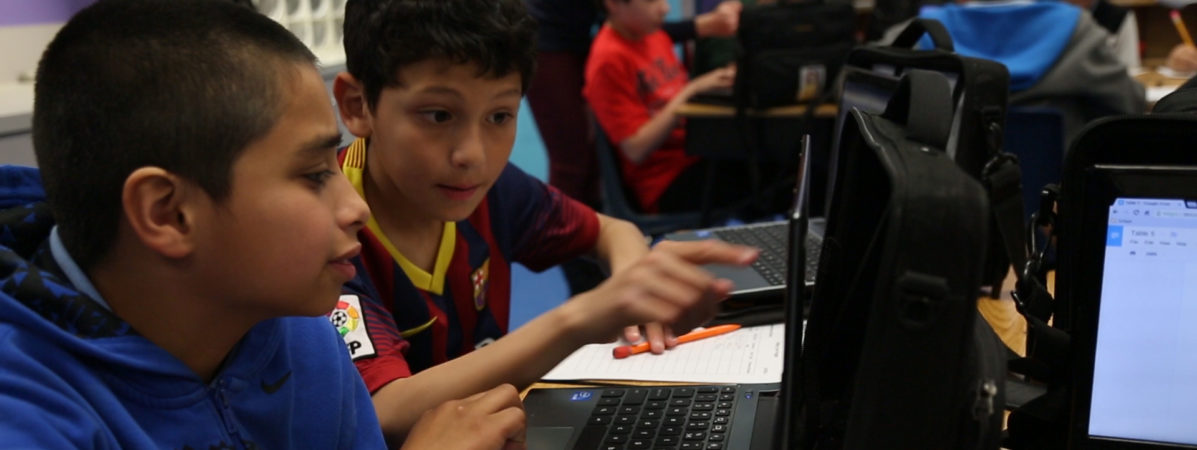
As you know, Digital Promise is committed to closing the Digital Learning Gap — ensuring that all learners have equitable access to technology, acquire the skills to fully participate in a connected world, and feel empowered to achieve their life and work goals.
Perhaps the single most significant development in ensuring access was the Federal Communications Commission’s (FCC) modernization of the E-rate program. Over the past 15 years, the E-rate program has achieved the goal of connecting almost every U.S. school and library to the Internet. However, as technology has advanced and adoption has increased, many of these connected schools and libraries no longer have adequate bandwidth to support demand. In modernizing E-rate, it is now more affordable for schools and libraries to upgrade their Internet connection speeds.
While high-speed Internet in our schools and libraries is necessary to ensure equitable access to learning opportunities, it is not sufficient. In 2015, the federal government — through programs such as ConnectHome, an extension of President Obama’s ConnectED initiative — and a growing number of school leaders are taking action to bring the Internet to students everywhere, both in and outside of school.
For example, the Coachella Valley Unified School District, a member of the Digital Promise League of Innovative Schools, creatively addressed this issue by providing WiFi-enabled school buses for connectivity to and from school. In addition, the buses park overnight in neighborhoods where Internet access is otherwise unavailable, giving students and their families the ability to stay connected at all times.
The League now represents more than 3.2 million students in 73 districts across 33 states and highlights how public schools are innovating and inspiring students and sharing knowledge and practices around digital transformation. This fall we convened with three districts on the outskirts of Pittsburgh. During that meeting, it became clear that the conversation among the most forward-thinking superintendents in the country has shifted from why to how technology is being used in the classroom, and how to ensure that digital transformation — which has become mainstream — can be more equally distributed. To capture the perspectives of League members on these topics, and how the League is setting a national agenda that other districts can follow, we rolled the cameras at our fall League meeting and invite you to see and hear what they had to say.
Also in 2015, we extended our Verizon Innovative Learning Schools initiative to 21 middle schools nationwide. The focus of this initiative remains educating and empowering teachers and students to be designers, creators and storytellers, smart consumers of digital media and learning content, as well as responsible digital citizens. We believe that engaging students today will prepare them with the skills necessary to succeed as adults.
We typically think of students as children or young adults, but there are 36 million adult learners in America who are struggling with literacy and numeracy and are under-served. A majority of these adults would like to improve their job skills, but need learning opportunities that meet their unique needs. Our Beacon Project includes libraries, community colleges, and other programs that are innovating and improving learning opportunities for adults. An important component of meeting the needs of adult learners is encouraging digital learning resource developers to enter this market. Our paper, Accelerating Change, written in partnership with Whiteboard Advisors, serves as a primer for developers and entrepreneurs seeking practical and rewarding ways to reach this demographic of learners.
Learners of all ages and types are at the core of what we do, and that includes educators looking for ways to continue to grow and remain engaged in their careers. With a focus on competency rather than seat time, our educator micro-credentials initiative supports the expansion of practical, personalized, self-directed learning. According to a recent survey conducted by Grunwald Associates, over 70 percent of teachers report they take advantage of informal professional development opportunities. In October, we launched our micro-credential platform, which includes more than 100 micro-credentials that can support professional goals.
As the use of technology for learning in and out of the classroom has grown, our Ed-Tech Pilots Report with the University of California-Davis looked at how innovative schools across the country try out, evaluate, and ultimately purchase the technology that ends up in classrooms. Our research findings show that using evidence, establishing set processes, and engaging and empowering stakeholders can improve purchasing decisions.
Using research to inform decisions improves learning products, but it also enhances teaching practices and student outcomes. Our (beta) research map bridges the gap between education research and those who can use the findings — educators and developers — to inform their work.
At Digital Promise we believe in the power of networks, stories, research, and personalizing learning. We know there is no shortage of excellence, but equity remains elusive. In 2016, we will continue our efforts to improve learning opportunities for ALL learners.
Thank you for your support. I wish you and your family a restorative holiday season and a productive new year.